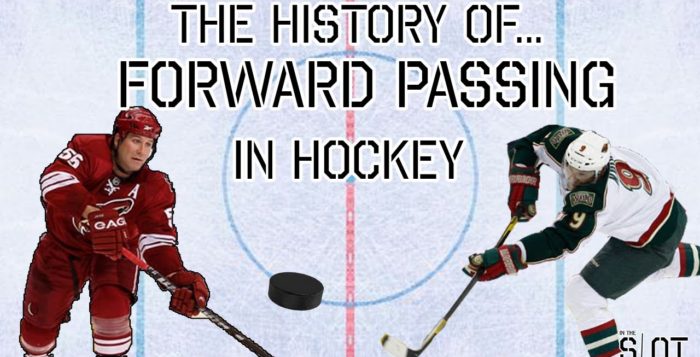This Day in Hockey History – September 28, 1929 – Passing the Puck
Most modern spectators would not enjoy hockey nearly as much without the forward pass, and a team’s passing game often is what gives it the edge over opponents. Though difficult to imagine now, ice hockey originally did not allow forward passing. It was not until September 28, 1929 that the NHL allowed forward passing in all zones.
Quite the innovators, brothers Lester and Frank Patrick introduced both the blue lines and forward passing between them to their Pacific Coast Hockey Association (PCHA) in 1913. Eastern teams found this, as the Toronto Daily Star put it, “an absurd rule … as the teams will discover as the season progresses.” During interleague games between the PCHA and the NHL (or its predecessor), they would alternate rules every other game of the series. For the 1918-19 season, the NHL also began allowing forward passing between teammates both situated in the neutral zone between the blue lines.
In an effort to speed up the game offensively, at the NHL meeting in Chicago on September 24, 1927, the NHL began allowing forward passing within the defensive zone by changing the offside rule. The new rule stated “a defending player shall not be considered offside in his area if he receives the puck in that area [between his own goal and the blue line].” They hoped to “materially cut down whistle-blowing for trivial off-sides which in themselves were of no advantage to the side offending in this respect.”
After a season of particularly low scoring, the NHL made another revision at the 1929 meeting, held at the Hotel Plaza in New York City. By popular demand, the board of governors implemented numerous changes meant to speed up the game by allowing more opportunities for scoring and less for whistle-blowing. Apparently, “some of the old-timers clung tenaciously to hockey as it has been played, but after much discussion it was conceded that the experiment might be worth while.”
The most impactful change involved the forward pass. Henceforth, the new rule stated, “The ice shall be divided into three sections known as the defending zone, the neutral zone, and the attacking zone. It is permitted to pass the puck forward by one player to another of the same side in each of these three zones, but it shall not be permitted to pass the puck by a player from one zone to a player of the same side in any other zone unless the player taking the pass crosses the zone line behind the puck.”
Immediately, they got their wish and saw scoring boosted dramatically, too dramatically. Scoring reached the double digits, and by December, teams were averaging 3.5 goals per game, over twice the previous average. The governors had left a loophole in that players could wait in the offensive zone for teammates to pass the puck. To combat that, on December 16, the modern offside rule was implemented. The scoring average per game dropped to 2.75, which was still higher than before but more manageable.
The 1927 and 1929 NHL meetings also introduced other rules meant to balance the game by restricting defensive measures. They strengthened the anti-defense rule in 1927 by prohibiting three defensive players from remaining behind their blue line when the play was happening in the opposite goal zone. In 1929, they permitted three players (including the goalie) from remaining in the defensive zone but implemented a minor penalty to be called on the fourth man to enter it while the puck was outside of that zone. The intention was to “prevent the defense from concentrating its forces around the goal.”
Another set of rules pertained to the goalie. In 1927, the NHL ruled that he could not hold the puck for longer than three seconds (or travelling with it more than four feet out from the net). Two years later, they ruled that if a goaltender was penalized for holding the puck, it will be placed 10 feet in front of the net, where two opposing players would face off. It was like a penalty shot but with the goalie assisted in defense by a teammate. The goalie was also henceforth prohibited from throwing the puck up the ice. As of 1927, anyone but the goalies who picked up the puck would receive a minor penalty.
The 1927 meeting introduced the interference rule in which any player not in possession of the puck would be penalized for cross-checking/holding/impeding-the-progress of any player also not in possession. At the 1929 meeting, the NHL put the kibosh on “jockeying” the puck behind the net. The new rule made it “mandatory for the player having the puck to carry out immediately.”
Additional Sources:
- Mike Commito, Hockey 365: Daily Stories from the Ice (Toronto: Dundurn, 2018), kindle edition
- Marshall D. Wright, The National Hockey League, 1917-1967: A Year-by-Year Statistical History (McFarland, 2014), 85-86.
- https://thepinkpuck.com/2018/12/16/this-day-in-hockey-history-december-16-1929-ruling-offside/
- “New Rules Put Scoring Punch in Pro Hockey,” New York Daily News, 29 Sept. 1929, p. 71.
- “National Hockey League Governors Adopt Forward Pass Rule To Aid Scoring,” Detroit Free Press, 29 Sept. 1929, p. 22.
- “Hockey League Adopts Schedule Changes Rules,” Chicago Tribune, 29 Sept. 1929, part 2, p. 5.
- “N.H.L. Adopts New Rules with View to Help Scoring,” Montreal Gazette, 30 Sept. 1929, p. 18.
- “Radical Changes in Pro Hockey Rules are Recommended,” Montreal Gazette, 7 Sept. 1927, p. 14.
- Alfred L. Schoenfeld, “Uniform Interpretation Of Rules Will Efface Deficiency in Hockey,” Brooklyn Daily Eagle, 26 Sept. 1927, p. 15.
- “Many Rule Changes Adopted by Major Pro Hockey Loop,” Montreal Gazette, 26 Sept. 1927, p. 14.
- https://www.vicnews.com/sports/the-forward-pass-forever-changed-hockey-100-years-ago/















[…] code of rules being seen at its best as a goal-scoring vehicle.” These new rules had been set on September 28, when forward passing in all zones was first allowed. Their intentions were to open up scoring […]